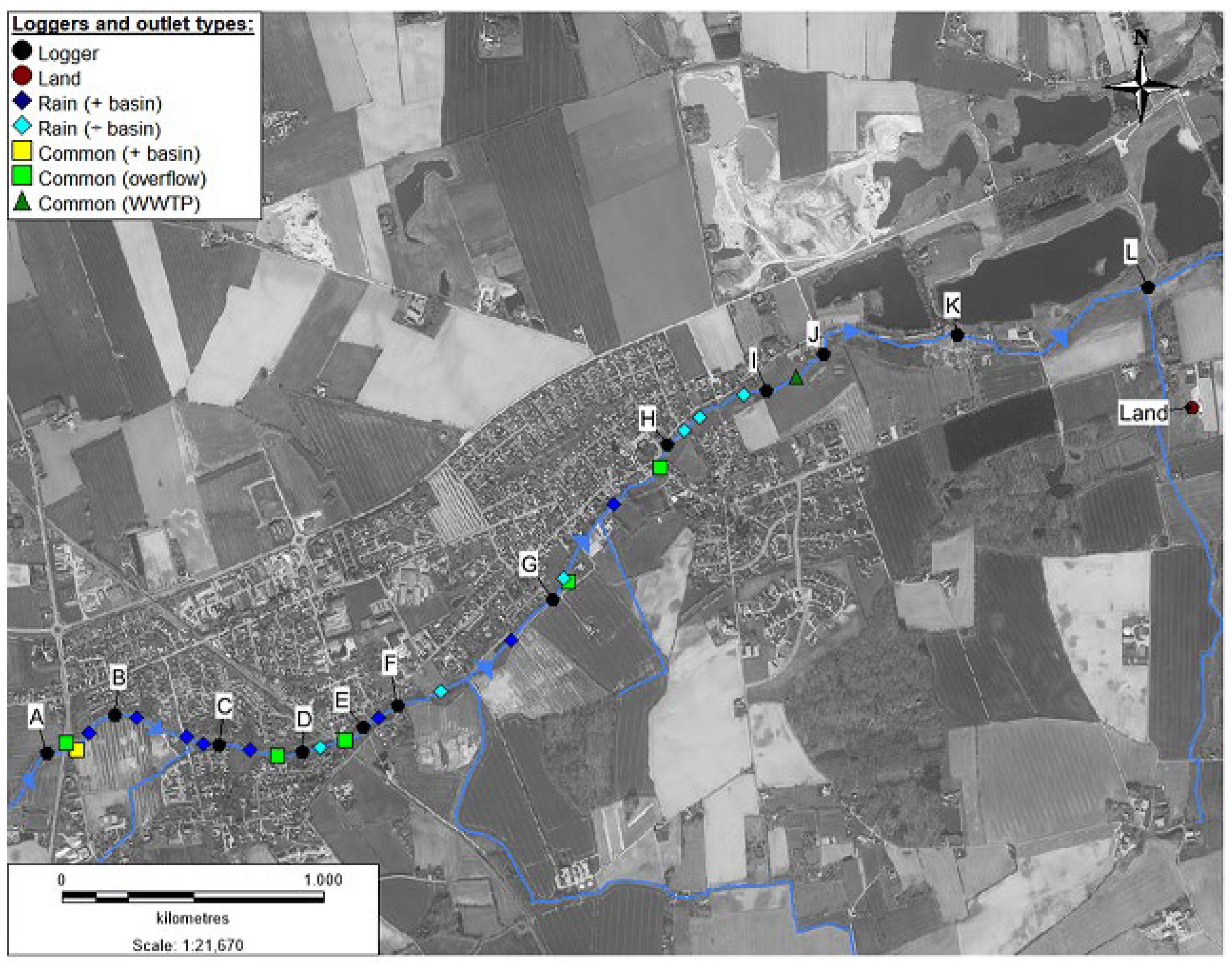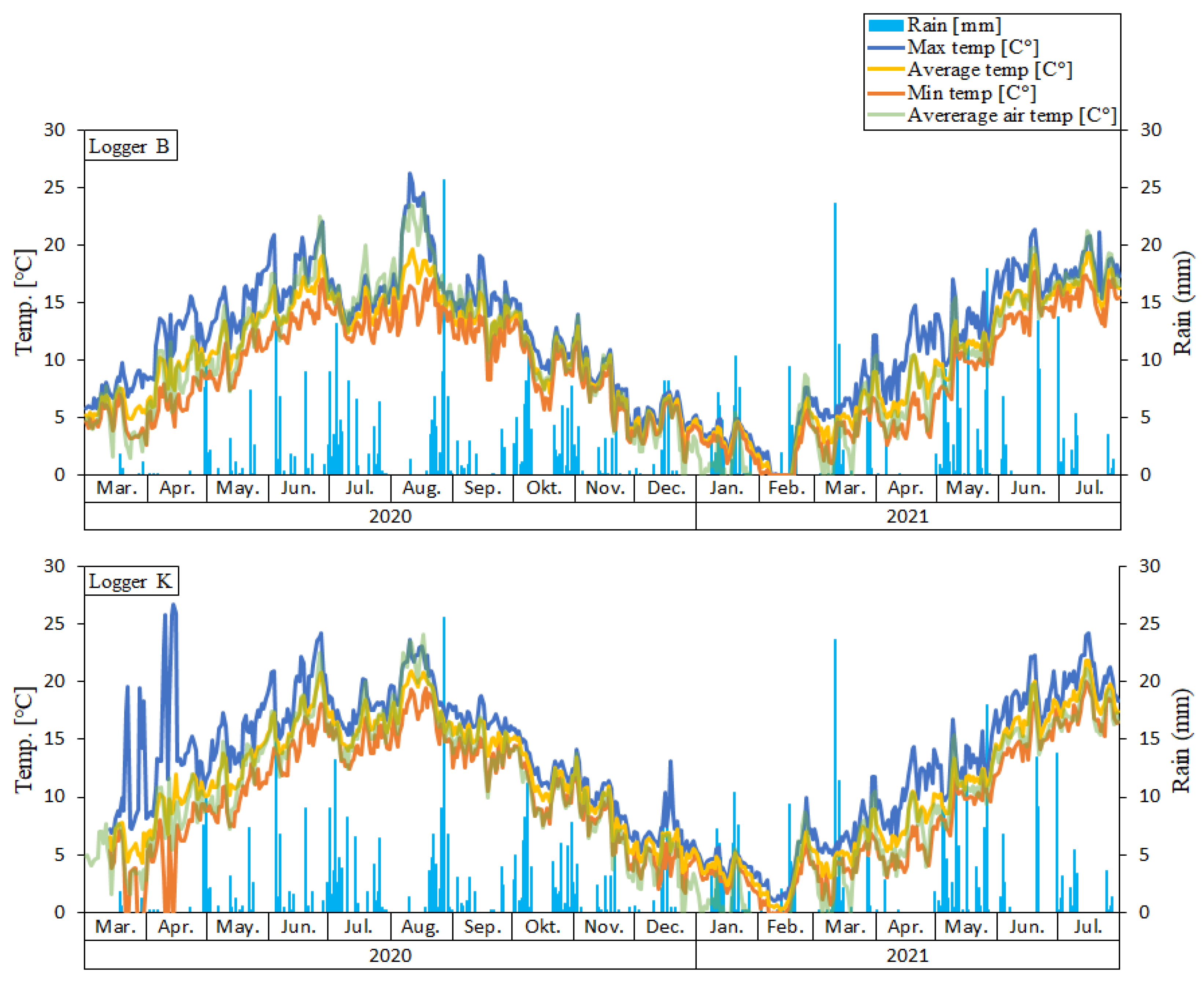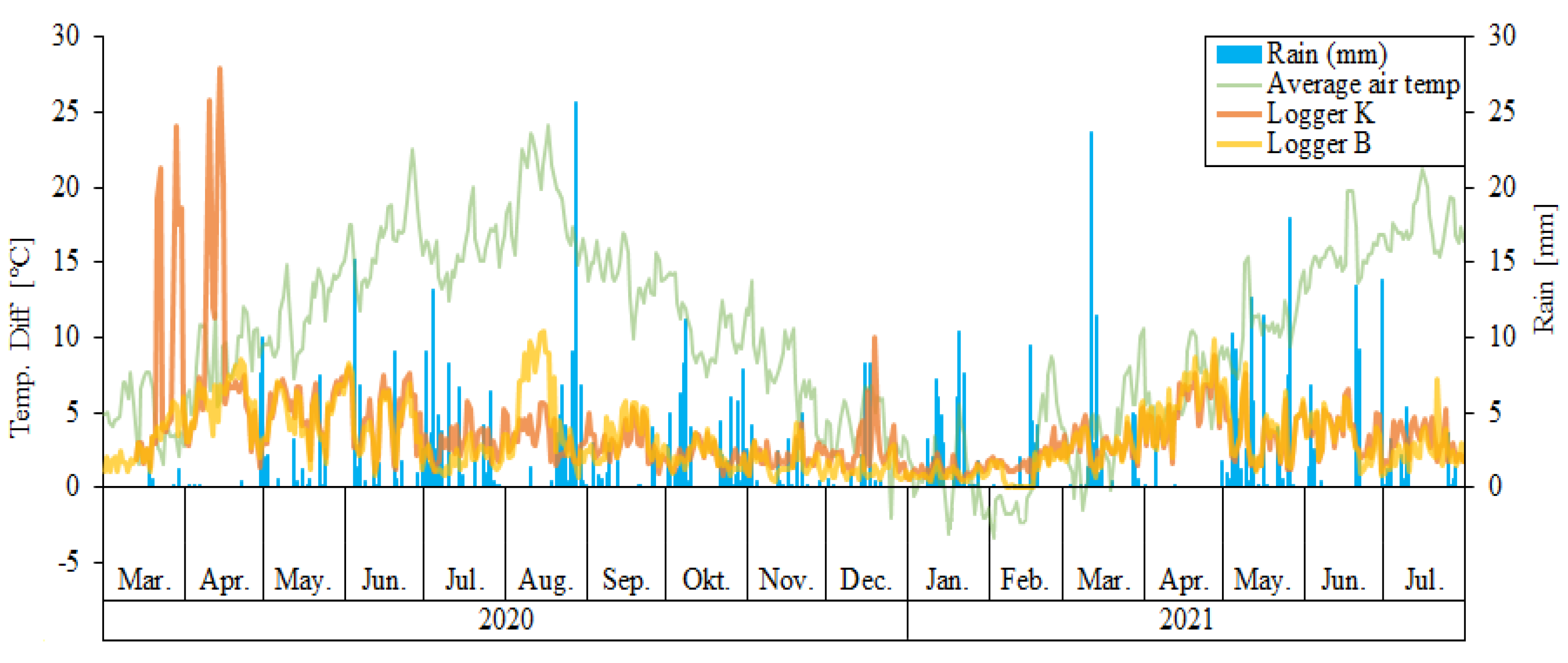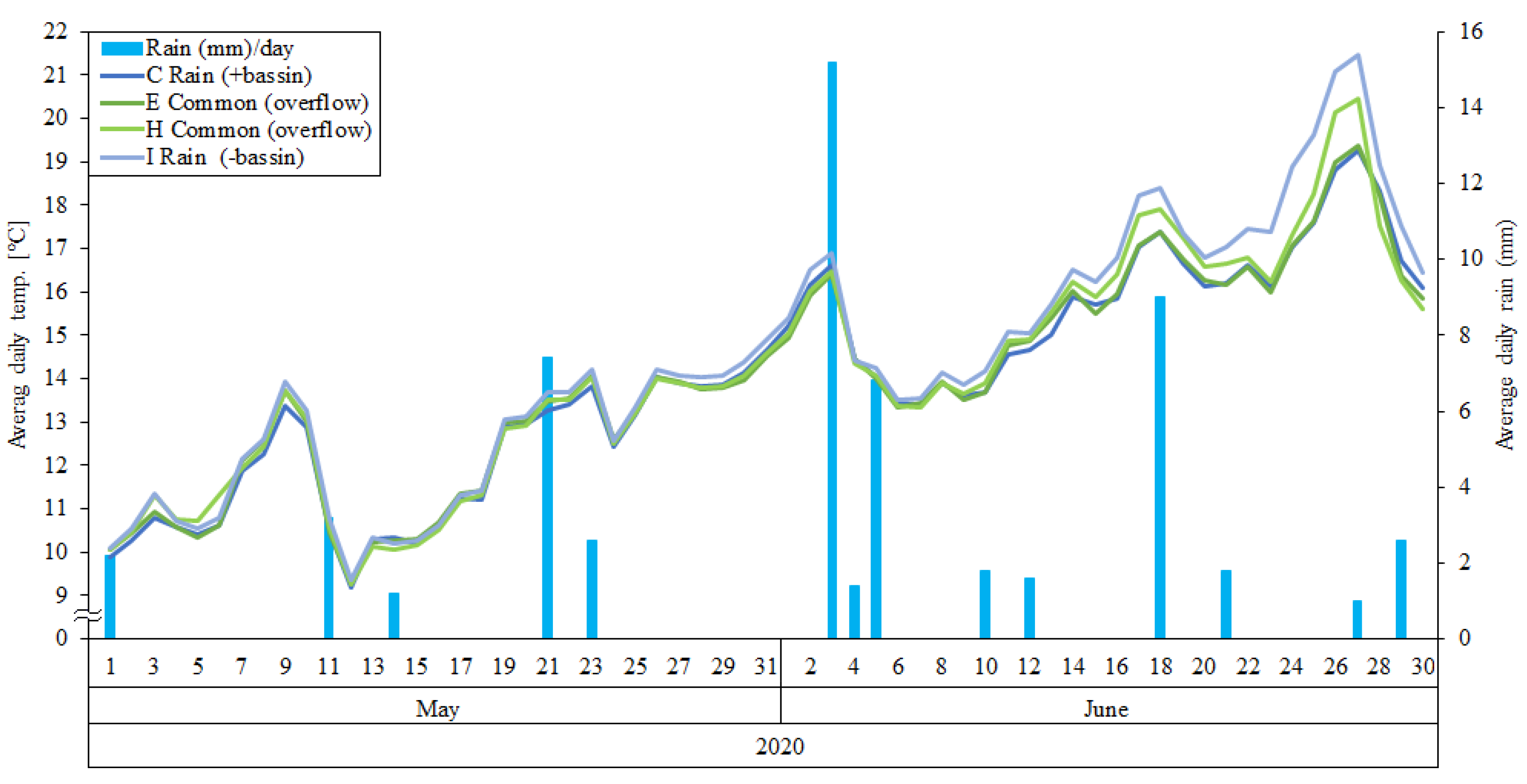Influences of Urban Discharges and Urban Heat Effects on Stream Temperature
Abstract
:1. Introduction
2. Materials and Methods
2.1. Study Area
2.2. Loggers and Placement
2.3. Statistical Analysis
3. Results
3.1. Seasonal Stream Variations in Temperature and Water Depth
3.2. The Effect of Different Outlet Types
3.3. Different Outlet Types of Response to Rain Events
4. Discussion
4.1. Urbanization Effect on the Stream Temperature
4.2. Temperature Rise through Aarslev Village
4.3. Temperature Differences Affected by Outlet Types
4.4. Ecological Condition and Consequences for Trout and Macroinvertebrates
4.5. Decrease in Temperature after Urbanized Area
5. Conclusions
Author Contributions
Funding
Institutional Review Board Statement
Informed Consent Statement
Data Availability Statement
Acknowledgments
Conflicts of Interest
References
- European Environmental Agency (Ed.) Climate Change and Floods in Europe; European Environmental Agency: Copenhagen, Denmark, 2005. [Google Scholar]
- Guerreiro, S.B.; Dawson, R.J.; Kilsby, C.; Lewis, E.; Ford, A. Future heat-waves, droughts and floods in 571 European cities. Environ. Res. Lett. 2018, 13, 034009. [Google Scholar] [CrossRef]
- Roudier, P.; Andersson, J.C.; Donnelly, C.; Feyen, L.; Greuell, W.; Ludwig, F. Projections of future floods and hydrological droughts in Europe under a+ 2 C global warming. Clim. Change 2016, 135, 341–355. [Google Scholar] [CrossRef] [Green Version]
- Trenberth, K.E. The impact of climate change and variability on heavy precipitation, floods, and droughts. Encycl. Hydrol. Sci. 2005, 17, 1–11. [Google Scholar]
- Mernild, S.H.; Hesselbjerg, J.; Cappelen, J. Precipitation extremes and arid summers. Aktuel Nat. 2019, 2, 8–12. [Google Scholar]
- Voogt, J.A.; Oke, T.R. Thermal remote sensing of urban climates. Remote Sens. Environ. 2003, 86, 370–384. [Google Scholar] [CrossRef]
- Oke, T.R. The energetic basis of the urban heat island. Q. J. R. Meteorol. Soc. 1982, 108, 1–24. [Google Scholar] [CrossRef]
- Somers, K.A.; Bernhardt, E.S.; Grace, J.B.; Hassett, B.A.; Sudduth, E.B.; Wang, S.; Urban, D.L. Streams in the urban heat island: Spatial and temporal variability in temperature. Freshw. Sci. 2013, 32, 309–326. [Google Scholar] [CrossRef] [Green Version]
- Pickett, S.T.; Cadenasso, M.L.; Grove, J.M.; Nilon, C.H.; Pouyat, R.V.; Zipperer, W.C.; Costanza, R. Urban ecological systems: Linking terrestrial ecological, physical, and socioeconomic components of metropolitan areas. Annu. Rev. Ecol. Syst. 2001, 32, 127–157. [Google Scholar] [CrossRef] [Green Version]
- Akbari, H.; Kolokotsa, D. Three decades of urban heat islands and mitigation technologies research. Energy Build. 2016, 133, 834–842. [Google Scholar] [CrossRef]
- Luan, X.; Yu, Z.; Zhang, Y.; Wei, S.; Miao, X.; Huang, Z.Y.; Teng, S.N.; Xu, C. Remote sensing and social sensing data reveal scale-dependent and system-specific strengths of urban heat island determinants. Remote Sens. 2020, 12, 391. [Google Scholar] [CrossRef] [Green Version]
- Sabouri, F.; Gharabaghi, B.; Mahboubi, A.; McBean, E. Impervious surfaces and sewer pipe effects on stormwater runoff temperature. J. Hydrol. 2013, 502, 10–17. [Google Scholar] [CrossRef]
- Rice, J.S.; Anderson Jr, W.P.; Thaxton, C.S. Urbanization influences on stream temperature behavior within low-discharge headwater streams. Hydrol. Res. Lett. 2011, 5, 27–31. [Google Scholar] [CrossRef]
- Galli, J. Thermal Impacts Associated with Urbanization and Stormwater Management Best Management Practices; Department of Environmental Programs, Metropolitan Washington Council of Governments: Washington, DC, USA, 1990. [Google Scholar]
- Zahn, E.; Welty, C.; Smith, J.A.; Kemp, S.J.; Baeck, M.L.; Bou-Zeid, E. The hydrological urban heat island: Determinants of acute and chronic heat stress in urban streams. JAWRA J. Am. Water Resour. Assoc. 2021, 57, 941–955. [Google Scholar] [CrossRef]
- Trenberth, K.E.; Jones, P.D.; Ambenje, P.; Bojariu, R.; Easterling, D.; Tank, A.K.; Parker, D.; Rahimzadeh, F.; Renwick, J.A.; Rusticucci, M. Observations: Surface and atmospheric climate change. In Climate Change 2007: The Physical Science Basis. Contribution of Working Group 1 to the 4th Assessment Report of the Intergovernmental Panel on Climate Change; Cambridge University Press: Cambridge, UK, 2007. [Google Scholar]
- DMI. Climateatlas. Available online: https://www.dmi.dk/klimaatlas/ (accessed on 13 January 2023).
- Croce, P.; Formichi, P.; Landi, F.; Mercogliano, P.; Bucchignani, E.; Dosio, A.; Dimova, S. The snow load in Europe and the climate change. Clim. Risk Manag. 2018, 20, 138–154. [Google Scholar] [CrossRef]
- Mote, P.W. Trends in snow water equivalent in the Pacific Northwest and their climatic causes. Geophys. Res. Lett. 2003, 30, 1601. [Google Scholar] [CrossRef] [Green Version]
- Søndergaard, M.; Kronvang, B.; Pejrup, M.; Sand-Jensen, K. Water and Weather in a 100 Years—Climate Changes and the Danish Waterenvironment; Forlaget Hovedland: Gjern, Denmark, 2006; Volume 1, pp. 55–73. [Google Scholar]
- Moore, T.L.; Hunt, W.F. Ecosystem service provision by stormwater wetlands and ponds—A means for evaluation? Water Res. 2012, 46, 6811–6823. [Google Scholar] [CrossRef]
- Prudencio, L.; Null, S.E. Stormwater management and ecosystem services: A review. Environ. Res. Lett. 2018, 13, 033002. [Google Scholar] [CrossRef]
- De Groot, R. Function-analysis and valuation as a tool to assess land use conflicts in planning for sustainable, multi-functional landscapes. Landsc. Urban Plan. 2006, 75, 175–186. [Google Scholar] [CrossRef]
- Herb, W.R.; Mohseni, O.; Stefan, H.G. Simulation of temperature mitigation by a stormwater detention pond 1. JAWRA J. Am. Water Resour. Assoc. 2009, 45, 1164–1178. [Google Scholar] [CrossRef]
- Jones, M.P.; Hunt, W.F. Effect of storm-water wetlands and wet ponds on runoff temperature in trout sensitive waters. J. Irrig. Drain. Eng. 2010, 136, 656–661. [Google Scholar] [CrossRef]
- Hørup, L.K.; Fink, M.S. Recipienteffects as a Consequence of Discharge from Wet Stormwater Ponds; The Faculty of Engineering and Natural Sciences, Aalborg University: Aalborg, Denmark, 2020. [Google Scholar]
- Sand-Jensen, K.; Bekkevold, D.; Christoffersen, K.S.; Hansen, M.M.; Lindgaard, C.; Nielsen, E.E.; Sivebæk, F.; Skov, C. Nature in Denmark the Fresh Waters; Gyldendal Publishing House: Copenhagen, Denmark, 2013; Volume 5, p. 504. [Google Scholar]
- Caissie, D. The thermal regime of rivers: A review. Freshw. Biol. 2006, 51, 1389–1406. [Google Scholar] [CrossRef]
- Vannote, R.L.; Sweeney, B.W. Geographic analysis of thermal equilibria: A conceptual model for evaluating the effect of natural and modified thermal regimes on aquatic insect communities. Am. Nat. 1980, 115, 667–695. [Google Scholar] [CrossRef]
- Hester, E.T.; Doyle, M.W. Human impacts to river temperature and their effects on biological processes: A quantitative synthesis 1. JAWRA J. Am. Water Resour. Assoc. 2011, 47, 571–587. [Google Scholar] [CrossRef]
- Hill, B.H.; Hall, R.; Husby, P.; Herlihy, A.; Dunne, M. Interregional comparisons of sediment microbial respiration in streams. Freshw. Biol. 2000, 44, 213–222. [Google Scholar] [CrossRef]
- Lee, R.M.; Rinne, J.N. Critical thermal maxima of five trout species in the southwestern United States. Trans. Am. Fish. Soc. 1980, 109, 632–635. [Google Scholar] [CrossRef]
- Grande, M.; Andersen, S. Critical thermal maxima for young salmonids. J. Freshw. Ecol. 1991, 6, 275–279. [Google Scholar] [CrossRef]
- Bremset, G. Seasonal and diel changes in behaviour, microhabitat use and preferences by young pool-dwelling Atlantic salmon, Salmo salar, and brown trout, Salmo trutta. Environ. Biol. Fishes 2000, 59, 163–179. [Google Scholar] [CrossRef]
- Ojanguren, A.F.; Reyes-Gavilán, F.G.; Braña, F. Thermal sensitivity of growth, food intake and activity of juvenile brown trout. J. Therm. Biol. 2001, 26, 165–170. [Google Scholar] [CrossRef]
- Lillehamnur, A.; Brittain, J.E.; Saltveit, S.J.; Nielsen, P.S. Egg development, nymphal growth and life cycle strategies in Plecoptera. Ecography 1989, 12, 173–186. [Google Scholar] [CrossRef]
- Stewart, B.A.; Close, P.G.; Cook, P.A.; Davies, P.M. Upper thermal tolerances of key taxonomic groups of stream invertebrates. Hydrobiologia 2013, 718, 131–140. [Google Scholar] [CrossRef]
- Gaufin, A.R.; Hern, S. Laboratory studies on tolerance of aquatic insects to heated waters. J. Kans. Entomol. Soc. 1971, 44, 240–245. [Google Scholar]
- Timm, A.; Ouellet, V.; Daniels, M. Swimming through the urban heat island: Can thermal mitigation practices reduce the stress? River Res. Appl. 2020, 36, 1973–1984. [Google Scholar] [CrossRef]
- Johnson, S.L. Factors influencing stream temperatures in small streams: Substrate effects and a shading experiment. Can. J. Fish. Aquat. Sci. 2004, 61, 913–923. [Google Scholar] [CrossRef]
- Jones, K.L.; Poole, G.C.; Meyer, J.L.; Bumback, W.; Kramer, E.A. Quantifying expected ecological response to natural resource legislation: A case study of riparian buffers, aquatic habitat, and trout populations. Ecol. Soc. 2006, 11, 15. [Google Scholar] [CrossRef] [Green Version]
- Olden, J.D.; Naiman, R.J. Incorporating thermal regimes into environmental flows assessments: Modifying dam operations to restore freshwater ecosystem integrity. Freshw. Biol. 2010, 55, 86–107. [Google Scholar] [CrossRef]
- Galli, J.; Dubose, R. Water Temperature and Freshwater Stream Biota: An Overview; US Environmental Protection Agency: Fort Meade, Maryland, 1990. [Google Scholar]
- Hathway, E.; Sharples, S. The interaction of rivers and urban form in mitigating the Urban Heat Island effect: A UK case study. Build. Environ. 2012, 58, 14–22. [Google Scholar] [CrossRef] [Green Version]
- Webb, B.W.; Hannah, D.M.; Moore, R.D.; Brown, L.E.; Nobilis, F. Recent advances in stream and river temperature research. Hydrol. Process. Int. J. 2008, 22, 902–918. [Google Scholar] [CrossRef]
- Nelson, K.C.; Palmer, M.A. Stream temperature surges under urbanization and climate change: Data, models, and responses 1. JAWRA J. Am. Water Resour. Assoc. 2007, 43, 440–452. [Google Scholar] [CrossRef]
- Wenger, S.J.; Roy, A.H.; Jackson, C.R.; Bernhardt, E.S.; Carter, T.L.; Filoso, S.; Gibson, C.A.; Hession, W.C.; Kaushal, S.S.; Martí, E. Twenty-six key research questions in urban stream ecology: An assessment of the state of the science. J. N. Am. Benthol. Soc. 2009, 28, 1080–1098. [Google Scholar] [CrossRef] [Green Version]
- DMI. Precipitation and Sun in Denmark. Available online: https://www.dmi.dk/klima/temaforside-klimaet-frem-til-i-dag/nedbor-og-sol-i-danmark/ (accessed on 14 January 2023).
- DMI. The Temperature in Denmark. Available online: https://www.dmi.dk/klima/temaforside-klimaet-frem-til-i-dag/temperaturen-i-danmark/ (accessed on 14 January 2023).
- Kuhlman, H.; Serritslev, L. Stream Vindinge. Available online: https://denstoredanske.lex.dk/Vindinge_%C3%85 (accessed on 23 March 2022).
- Webb, B.W.; Nobilis, F. Long-term changes in river temperature and the influence of climatic and hydrological factors. Hydrol. Sci. J. 2007, 52, 74–85. [Google Scholar] [CrossRef]
- Crisp, D.; Howson, G. Effect of air temperature upon mean water temperature in streams in the North Pennines and English Lake District. Freshw. Biol. 1982, 12, 359–367. [Google Scholar] [CrossRef]
- Erickson, T.R.; Stefan, H.G. Correlations of Oklahoma Stream Temperatures with Air Temperatures; St. Anthony Falls Laboratory, University of Minnesota Digital Conservancy: Minneapolis, MN, USA, 1996; pp. 1–32. [Google Scholar]
- Pilgrim, J.M.; Fang, X.; Stefan, H.G. Stream temperature correlations with air temperatures in Minnesota: Implications for climate warming 1. JAWRA J. Am. Water Resour. Assoc. 1998, 34, 1109–1121. [Google Scholar] [CrossRef]
- Kieser, M.S.; Spoelstra, J.A.; Fang, A.F.; James, W.; Li, Y. Stormwater Thermal Enrichment in Urban Watersheds; Water Environment Research Foundation: Alexandria, VA, USA, 2003. [Google Scholar]
- Lieb, D.A.; Carline, R.F. Effects of urban runoff from a detention pond on water quality, temperature and caged Gammarus minus (Say) (Amphipoda) in a headwater stream. Hydrobiologia 2000, 441, 107–116. [Google Scholar] [CrossRef]
- Sabouri, F.; Gharabaghi, B.; Perera, N.; McBean, E. Evaluation of the thermal impact of stormwater management ponds. J. Water Manag. Model. 2013. [Google Scholar] [CrossRef] [Green Version]
- Martin, R.; Carvajal Sanchez, S.; Welker, A.; Komlos, J. Thermal effects of stormwater control measures on a receiving headwater stream. J. Sustain. Water Built Environ. 2021, 7, 06020002. [Google Scholar] [CrossRef]
- Jones, M.P.; Hunt, W.F. Bioretention impact on runoff temperature in trout sensitive waters. J. Environ. Eng. 2009, 135, 577–585. [Google Scholar] [CrossRef]
- Kang, S.; Kim, S.; Lee, S.; Lee, T. An Upflow-Type Filtration Device Using Expanded Polypropylene Media (EPM) to Treat First Flush of Rainwater. Water Environ. Res. 2016, 88, 195–200. [Google Scholar] [CrossRef]
- Yaziz, M.I.; Gunting, H.; Sapari, N.; Ghazali, A. Variations in rainwater quality from roof catchments. Water Res. 1989, 23, 761–765. [Google Scholar] [CrossRef]
- Gupta, K.; Saul, A.J. Specific relationships for the first flush load in combined sewer flows. Water Res. 1996, 30, 1244–1252. [Google Scholar] [CrossRef]
- Batroney, T.; Wadzuk, B.M.; Traver, R.G. Parking deck’s first flush. J. Hydrol. Eng. 2010, 15, 123–128. [Google Scholar] [CrossRef]
- Skovmark, B. How Is the Recipient’s Vulnerability Assessed? Available online: http://www.evanet.dk/hvordan-vurderes-recipienternes-saarbarhed/ (accessed on 10 August 2022).
- Arora, R.; Tockner, K.; Venohr, M. Changing river temperatures in northern Germany: Trends and drivers of change. Hydrol. Process. 2016, 30, 3084–3096. [Google Scholar] [CrossRef]
- Van Vliet, M.T.; Franssen, W.H.; Yearsley, J.R.; Ludwig, F.; Haddeland, I.; Lettenmaier, D.P.; Kabat, P. Global river discharge and water temperature under climate change. Glob. Environ. Change 2013, 23, 450–464. [Google Scholar] [CrossRef]
- O’Reilly, C.M.; Sharma, S.; Gray, D.K.; Hampton, S.E.; Read, J.S.; Rowley, R.J.; Schneider, P.; Lenters, J.D.; McIntyre, P.B.; Kraemer, B.M. Rapid and highly variable warming of lake surface waters around the globe. Geophys. Res. Lett. 2015, 42, 10773–10781. [Google Scholar] [CrossRef]
- Till, A.; Rypel, A.L.; Bray, A.; Fey, S.B. Fish die-offs are concurrent with thermal extremes in north temperate lakes. Nat. Clim. Change 2019, 9, 637–641. [Google Scholar] [CrossRef]
- Crozier, L.G.; Hutchings, J.A. Plastic and evolutionary responses to climate change in fish. Evol. Appl. 2014, 7, 68–87. [Google Scholar] [CrossRef] [PubMed]







| Logger ID | EUREF89_zone32 | Upstream Outlet Type | Distance from Outlet [m] |
|---|---|---|---|
| A | 592,146; 6,129,101 | Rain (÷Basin) | 10 |
| B | 592,416; 6,129,257 | Rain (+Basin) | 130 |
| C | 592,800; 6,129,167 | Rain (+Basin) | 10 |
| D | 593,140; 6,129,119 | Common (Overflow) | 100 |
| E | 593,316; 6,129,160 | Common (Overflow) | 10 |
| F | 593,503; 6,129,290 | Rain (+Basin) | 20 |
| G | 594,105; 6,129,684 | Rain (+Basin) | 150 |
| H | 594,534; 6,130,281 | Common (Overflow) | 100 |
| I | 594,906; 6,130,510 | Rain (÷Basin) | 300 |
| J | 595,042; 6,130,559 | Common (WWTP) | 25 |
| K | 595,650; 6,130,724 | Common (WWTP) | 725 |
| L | 596,396;6,130,905 | Common (WWTP) | 1630 |
| One Way ANOVA on Ranks (Tukey Test) | |||||
|---|---|---|---|---|---|
| Season | Stations | N | Diff of Ranks | p | p < 0.050 |
| Summer 2020 | A vs. K | 8760 | 14168388 | <0.001 | yes |
| Winter 2020 | A vs. K | 8926 | 20696869 | <0.001 | yes |
| Summer 2021 | A vs. K | 8768 | 7959435 | <0.001 | yes |
| Month | A | B | C | D | E | F | G | H | I | J | K | L | |
|---|---|---|---|---|---|---|---|---|---|---|---|---|---|
| Jan. | avg ± SD | 3.1 ± 0.9 | 3.2 ± 0.9 | 3.3 ± 0.8 | 3.1 ± 0.8 | 3.3 ± 0.8 | 3.1 ± 0.9 | 3.0 ± 0.9 | 3.5 ± 0.9 | 3.4 ± 0.9 | 3.4 ± 0.9 | 3.7 ± 0.9 | 3.9 ± 0.8 |
| Feb. | avg ± SD | 2.1 ± 2.3 | 2.2 ± 2.4 | 2.4 ± 2.2 | 2.2 ± 2.3 | 2.4 ± 2.3 | 2.2 ± 2.3 | 2.2 ± 2.4 | 2.4 ± 2.4 | 2.4 ± 2.4 | 2.4 ± 2.4 | 2.6 ± 2.2 | 2.9 ± 2.2 |
| March | avg ± SD | 5.3 ± 1.8 | 5.6± 1.7 | 5.5 ± 1.6 | 5.4 ± 1.7 | 5.7 ± 1.7 | 5.4 ± 1.7 | 5.4 ± 1.7 | 5.6 ± 1.7 | 5.6 ± 1.8 | 5.6 ± 1.8 | 5.6 ± 2.5 | 5.9 ± 1.5 |
| April | avg ± SD | 8.2 ± 2.7 | 8.3 ± 2.7 | 8.2 ± 2.6 | 8.1 ± 2.7 | 8.3 ± 2.6 | 8.1 ± 2.6 | 8.1 ± 2.8 | 8.3 ± 2.7 | 8.4 ± 2.7 | 8.4 ± 2.7 | 8.6 ± 3.1 | 8.7 ± 2.3 |
| May | avg ± SD | 11.4 ± 2.1 | 11.6 ± 2.2 | 11.5 ± 2.3 | 11.5 ± 2.3 | 11.7 ± 2.3 | 11.5 ± 2.3 | 11.4 ± 2.3 | 11.6 ± 2.3 | 11.7 ± 2.4 | 11.7 ± 2.4 | 11.9 ± 2.6 | 11.8 ± 2.0 |
| June. | avg ± SD | 15.5 ± 1.8 | 15.7 ± 2.0 | 15.9 ± 1.9 | 15.9 ± 2.1 | 16.0 ± 2.0 | 16.1 ± 2.2 | 16.0 ± 2.3 | 16.2 ± 2.3 | 16.5 ± 2.5 | 16.5 ± 2.4 | 16.8 ± 2.3 | 16.3 ± 2.1 |
| July. | avg ± SD | 15.4 ± 1.9 | 15.5 ± 1.8 | 16.0 ± 1.9 | 16.0 ± 2.0 | 16.1 ± 1.9 | 16.5 ± 2.2 | 16.4 ± 2.3 | 16.7 ± 2.3 | 16.9 ± 2.3 | 16.9 ± 2.2 | 17.4 ± 2.1 | 16.8 ± 2.0 |
| Aug. | avg ± SD | 15.2 ± 1.5 | 16.0 ± 2.1 | 15.9 ± 1.6 | 16.3 ± 1.9 | 16.4 ± 1.8 | 16.3 ± 2.1 | 15.9 ± 1.7 | 16.9 ± 2.6 | 16.8 ± 2.3 | 16.7 ± 1.9 | 17.5 ± 2.0 | 16.7 ± 1.6 |
| Sept. | avg ± SD | 14.2 ± 1.5 | 13.6 ± 1.7 | 13.7 ± 1.6 | 13.6 ± 1.7 | 13.8 ± 1.5 | 13.8 ± 1.9 | 14.6 ± 1.6 | 14.2 ± 1.7 | 14.2 ± 1.7 | 14.2 ± 1.2 | 15.4 ± 1.3 | 14.6 ± 1.4 |
| Oct. | avg ± SD | ≠ | 10.5 ± 2.0 | 10.7 ± 1.9 | 10.5 ± 2.0 | 10.7 ± 2.0 | 10.6 ± 2.0 | ≠ | 10.8 ± 2.0 | 10.8 ± 2.0 | 11.0 ± 2.0 | 11.9 ± 1.8 | 11.7 ± 1.7 |
| Nov. | avg ± SD | 4.6 ± 1.2 | 7.8 ± 2.4 | 8.0 ± 2.3 | 6.9 ± 3.3 | 8.0 ± 2.4 | 7.8 ± 2.4 | ≠ | 8.0 ± 2.4 | 7.9 ± 2.5 | 8.4 ± 2.1 | 8.8 ± 2.1 | 8.9 ± 2.0 |
| Dec. | avg ± SD | 4.8 ± 1.2 | 4.8 ± 1.2 | 4.9 ± 1.2 | 4.3 ± 1.5 | 4.9 ± 1.2 | 4.7 ± 1.6 | ≠ | 4.9 ± 1.3 | 4.8 ± 1.3 | 5.1 ± 1.1 | 5.6 ± 1.2 | 6.0 ± 0.9 |

Disclaimer/Publisher’s Note: The statements, opinions and data contained in all publications are solely those of the individual author(s) and contributor(s) and not of MDPI and/or the editor(s). MDPI and/or the editor(s) disclaim responsibility for any injury to people or property resulting from any ideas, methods, instructions or products referred to in the content. |
© 2023 by the authors. Licensee MDPI, Basel, Switzerland. This article is an open access article distributed under the terms and conditions of the Creative Commons Attribution (CC BY) license (https://creativecommons.org/licenses/by/4.0/).
Share and Cite
Kolath, A.S.; Egemose, S. Influences of Urban Discharges and Urban Heat Effects on Stream Temperature. Hydrology 2023, 10, 30. https://doi.org/10.3390/hydrology10020030
Kolath AS, Egemose S. Influences of Urban Discharges and Urban Heat Effects on Stream Temperature. Hydrology. 2023; 10(2):30. https://doi.org/10.3390/hydrology10020030
Chicago/Turabian StyleKolath, Anja Svane, and Sara Egemose. 2023. "Influences of Urban Discharges and Urban Heat Effects on Stream Temperature" Hydrology 10, no. 2: 30. https://doi.org/10.3390/hydrology10020030





